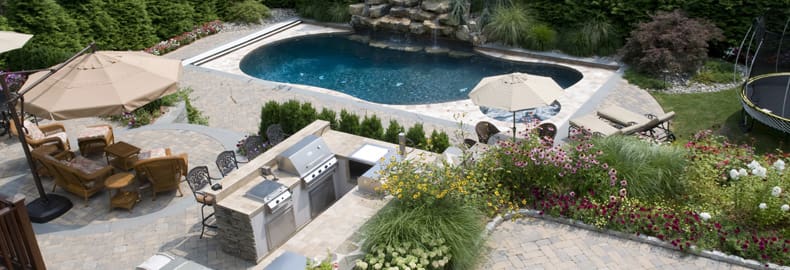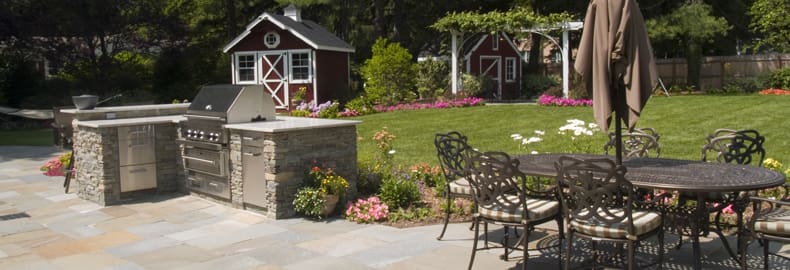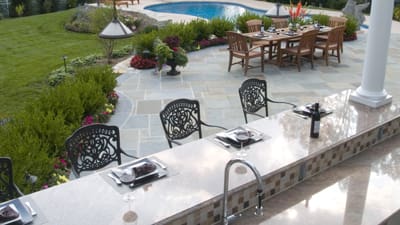 Relaxing outdoors with the family is the perfect way to spend a lovely summer evening. With the popular addition of outdoor kitchens, the backyard is now a second kitchen, dining room and living room for many homeowners. Outdoor kitchen installation provides an easy way to cook favorite family meals and dine under the stars.
Relaxing outdoors with the family is the perfect way to spend a lovely summer evening. With the popular addition of outdoor kitchens, the backyard is now a second kitchen, dining room and living room for many homeowners. Outdoor kitchen installation provides an easy way to cook favorite family meals and dine under the stars.
Outdoor kitchens provide everything you need to cook simple burgers or gourmet dinners. State-of-the-art appliances with luxury features and professional-grade cooking equipment create outdoor kitchens fit for any gourmet chef. Whether you’re a top-notch cook or a great grill master, an outdoor kitchen installation lets you enjoy cooking in the back yard with your family.
An outdoor kitchen will provide years of backyard enjoyment for your family, but proper outdoor kitchen installation procedures should be followed. Take note of some important tips to keep your family and your home safe.
What’s the Best Location for an Outdoor Kitchen?
It’s best to locate your outdoor kitchen close to the house for lower costs, convenience and safety.
- Costs – Outdoor kitchen installation requires power and water. Gas appliances need a gas line. Electric appliances need wiring and electrical power. Refrigerators, ice makers and dishwashers need a water line. Locating your kitchen close to the house will keep utility costs down.
- Convenience – By locating your outdoor kitchen close to the house, you can use indoor appliances, equipment and storage for convenience. There may be times when you choose to cook outdoors and eat indoors. Keeping the outdoor kitchen close to the house will allow you quickly move inside.
- Safety – An outdoor kitchen that’s close to the house offers more privacy and protection from northern NJ weather that can include excessive heat, rain, snow and high winds that can result in falling trees and power lines.
If you prefer a more remote location in your back yard, your outdoor kitchen needs to be entirely self-sufficient with a gas lines, electrical wiring, outlets, water lines and proper drainage. Utilities should be installed by a professional licensed contractor to ensure that all gas, electric and water hookups meet local building code regulations in Bergen County, NJ.
With a remote location, choose an area for outdoor kitchen installation that provides some privacy, but doesn’t pose a fire risk to nearby trees or structures in the landscape. Consider prevailing winds when you’re cooking to prevent sparks and smoke from blowing back in your face or towards family and guests in a nearby seating area.
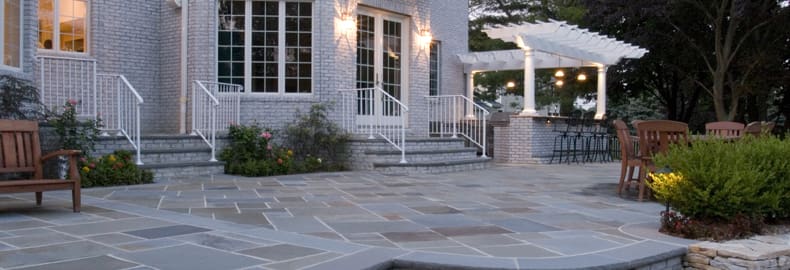
Is My Existing Patio Safe?
If you want to build your outdoor kitchen on an existing patio, you need to make sure it will support the extra weight. Depending on the age and condition of your existing patio, you may need additional support. For best long-term results, your new outdoor kitchen installation should include its own separate foundation for several reasons:
- Weight – Standard concrete patios are typically built 4” thick. The weight of most outdoor kitchens when fully equipped is too heavy for 4” concrete. It will likely crack causing damage to your new outdoor kitchen.
- Drainage – For proper water drainage, the foundation for your outdoor kitchen should be at least 1/4” to 1/2” higher than your existing patio surface. If not, water can back up into your kitchen or sit stagnantly under the kitchen causing mold and mildew.
- Replacement – If you decide to change your patio, your outdoor kitchen will have to be torn out to get to the patio surface below it. If it has its own foundation, you can rebuild around it.
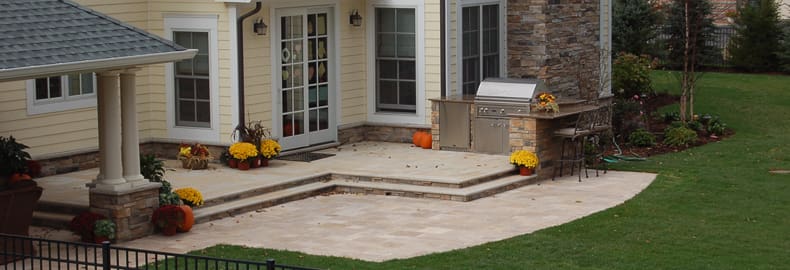
What Are the Safest Materials?
Framework
The basic framework for your outdoor kitchen installation should be galvanized steel or concrete block. Galvanized steel studs are faster, cheaper and leave more room inside the cabinet for appliances and equipment. All utilities should be stubbed through the floor of the framework so they aren’t visible from outside the kitchen.
Materials
The framework can be covered in a variety of materials like natural stone (granite, limestone, slate, flagstone, river rock), or brick, stucco, concrete, wood and tile. The cheapest options are stucco and concrete. The most expensive option is natural stone. Select materials that are easy to clean and maintain and compliment the architectural style of your home.
Custom countertops can be made from natural stones, brick pavers, concrete and tile, as well as cultured stone (man-made materials) which is less expensive. Select materials that resist spills and stains easily. Select materials with heat resistant properties to handle a hot pot without scorching or burning. Some materials may require a sealant for protection. Talk to your outdoor kitchen contractor about the best countertop materials for your home.
Framework and countertop materials for your outdoor kitchen installation should be suitable for northern NJ weather conditions, especially in cold winters with snow and ice. Look for materials that won’t crack in freezing temperatures.
Safety Precautions
- Ventilation – Proper ventilation for fire, smoke and soot is essential. High-powered grills needs grease pans for dripping grease and food particles that can build up and start a fire. Grill vent hoods are available in wall-mounted and island designs for outdoor kitchens.
- Fire – Whether your outdoor kitchen is located close to the house or in a remote yard location, make sure there’s a fire extinguisher on hand. Provide a gas safety shutoff valve near your outdoor kitchen installation that’s not too close to the grill. Don’t locate your outdoor kitchen under your house roof line, against wooden fencing or under low trees and shrubs.
- Shelter – Provide adequate shelter from sun, rain and wind for your family and guests. Consider a cover that protects your outdoor kitchen when it’s not in use. In hot direct sunlight, materials and equipment can get hot to the touch. In cold weather, you may need gas heaters, a fire pit or a fireplace for added warmth. If you plan to cook and entertain at night, make sure you include adequate lighting for your outdoor kitchen area. Lastly, don’t forget about protection from bugs and mosquitoes that will ruin your outdoor kitchen experience.

